
By PATRICK CAIRNS
Twice a year, every year, the SPIVA (S&P Indices Versus Active Funds) scorecards across the world show the same long-term results: most active equity managers under-perform, most of the time.
For example, the most recent mid-year scorecard for the UK, showed that 69.33% of UK equity fund managers had failed to beat the S&P United Kingdom BMI Index over the past 10 years.
Similar figures have been reported ever since the SPIVA scorecards were first launched in 2002. And unless something really fundamental changes, investors should expect these sorts of results to persist.
As Craig Lazzara, global head of index investment strategy at S&P Dow Jones Indices recently pointed out, this is not some kind of fluke. Neither is it an anomaly. It is perfectly logical.
“The most important thing to realize about SPIVA results is that they are not a coincidence,” writes Lazzara. “The active management community didn’t lose a cosmic coin flip 90 years ago; active underperformance happens for a set of readily identifiable reasons.”
Professionalisation
The first of those has been best explained by Charley Ellis, author of Winning the Loser’s Game. He points out that 60 years ago, success in active management was possible, and even probable with the right set of skills.
However, over the past few decades markets have become increasingly professionalised. Almost all the buying and selling is now done not by individual investors, but by professionals.
“When I was first getting started (in investment management), back in the early 60s… 90% of (trading) was done by individuals who did a trade every year or two or three,” says Ellis. “Now, 99% of trading is done by institutional investors.
“That means virtually every time you buy, you must be buying from a professional. And every time you sell, you’re selling to a professional. And what’s happened to the professionals? They’ve got better and better and better and better.”
Standing out
The point is that active managers don’t struggle to beat the market because they aren’t good. It’s quite the opposite. They struggle to beat the market because they are so good at what they do.
“Portfolio management is a zero-sum game; the only source of alpha for the winners is the negative alpha of the losers,” Lazzara points out. “When most of the assets in a market are professionally managed, the average professional won’t beat the market because the average professional is the market.”
It is extremely difficult to have any kind of advantage when everyone has access to the same information, the same skills and the same ability to trade. That is why it should be no surprise that so few active managers are able to stand out.
Long-term success requires short-term under-performance
In a previous article, Lazzara identified another reason why active management is so hard — it requires long-term courage and conviction because of the way that share prices tend to move. It also reserves huge reserves of patience, which, as Robin Powell pointed out in his latest post, the vast majority of investors (including the professionals) simply don’t possess.
He pointed out that if you had invested $1,000 in Apple at the wrong time at the start of this century, your investment could have fallen to as low as $275 when the tech bubble burst. It would have been extremely difficult to hold onto that investment at that point, when you had lost nearly three-quarters of your money.
If you had, however, that $1,000 would have since grown to $155,000.
The problem is that fund managers tend to get fired if they lose 75% of the value of their portfolio. Or, at the very least, they lose the confidence of their clients.
A fund manager would have needed to hold out through that massive loss to see the eventual gain. Few, however, would have been given the chance.
Long-term
Morningstar made a similar observation in 2018 in a paper titled How long can a good fund underperform its benchmark?
It found that fund that were long-term outperformers – that had beaten their benchmarks over 15 years – had underperformed that same benchmark for an average of nine to 12 years during that period.
“One of the reasons that active management is so difficult is that the correct investment choice may not be the easy choice,” explains Lazzara. “The challenge for an active manager is not limited to identifying the relatively small number of long-term winners. Success also requires holding the long-term winners when they go through painful periods of short-term underperformance.
“Conviction and confidence are not enough to win the day — courage is also needed, and most needed precisely when it’s hardest to muster.”
One of South Africa’s most respected financial journalists, PATRICK CAIRNS is a trusted commentator on the world of investments and the quirks of behavioural finance. Over more than a decade he has built a reputation for keeping the industry honest, and putting the interests of investors first.
© The Evidence-Based Investor MMXX









